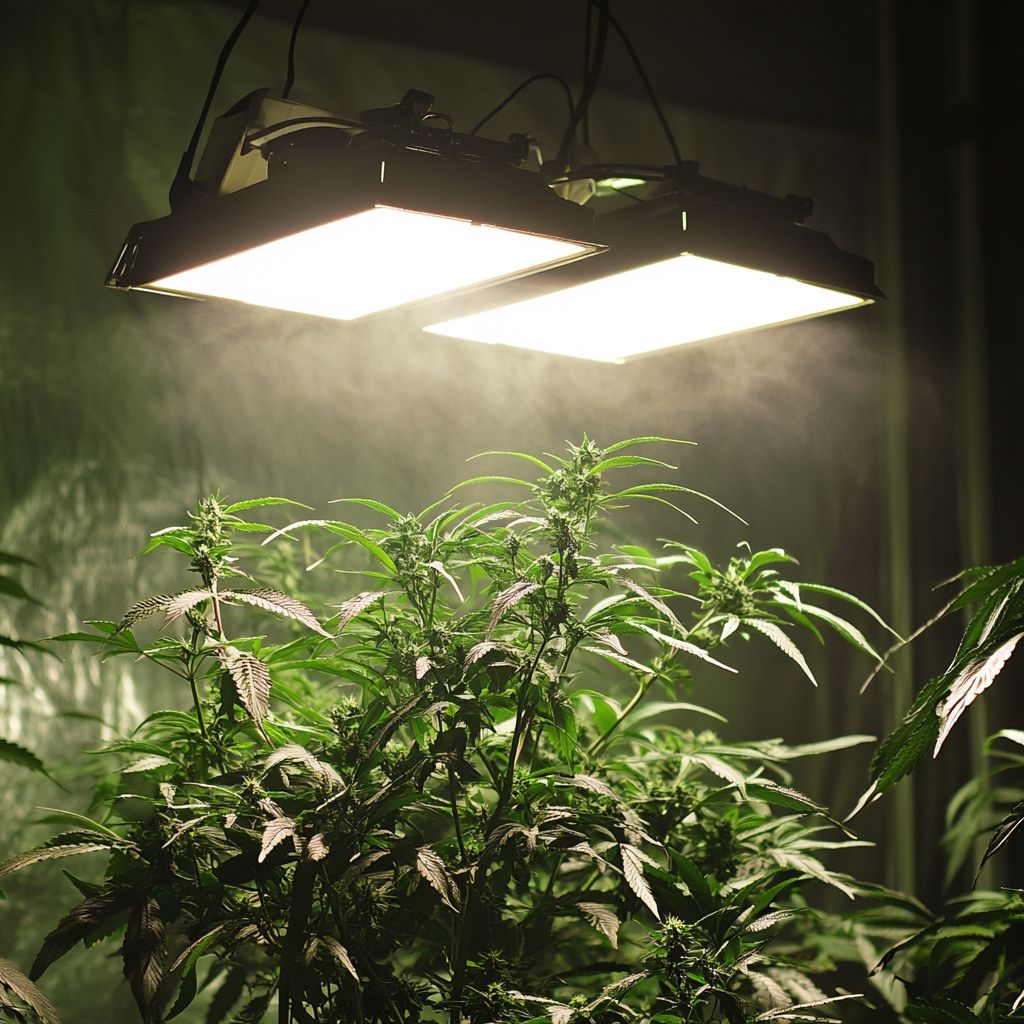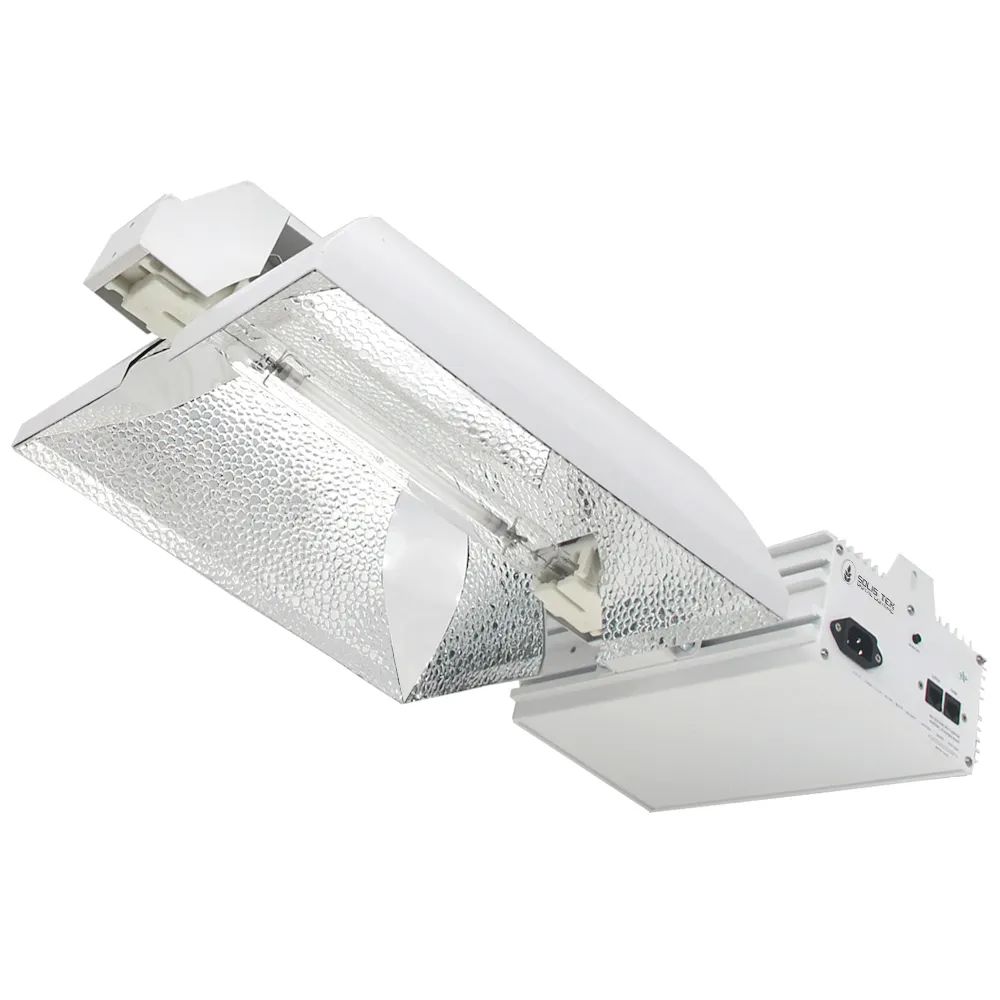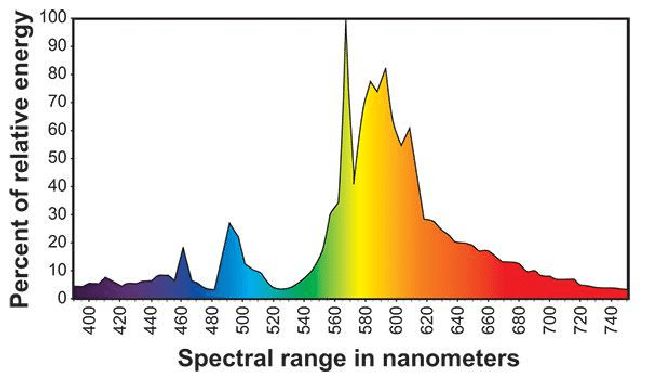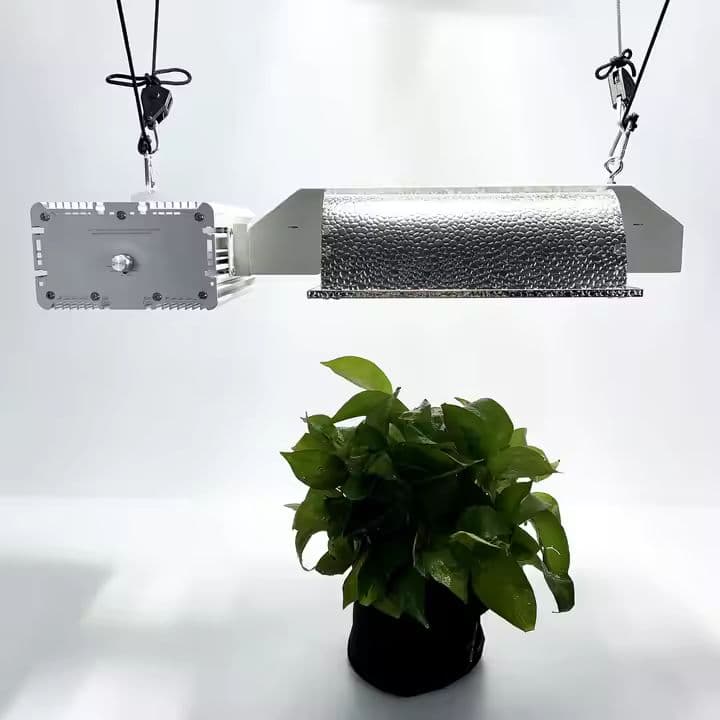CMH or HPS? Find Out Which Grow Light Delivers Better Results
Indoor gardening is a science. It requires the right tools and knowledge to yield the best results.
One crucial aspect is lighting.
Grow lights play a pivotal role in indoor horticulture. They can significantly impact plant health, growth, and yield. But with so many options available, choosing the right one can be daunting.
Two popular choices are HPS (High-Pressure Sodium) and CMH (Ceramic Metal Halide) grow lights.
This article aims to compare HPS vs CMH grow lights. We'll delve into their features, benefits, and drawbacks. Our goal is to help you make an informed decision on which lighting system best suits your needs.
Whether you're an indoor gardener, a hydroponic enthusiast, or a commercial grower, this guide will provide valuable insights. Let's shed some light on the HPS vs CMH debate.
Understanding HPS and CMH Grow Lights
HPS and CMH grow lights have unique characteristics. Understanding them can help optimize your indoor gardening efforts.
HPS lights have been around for a long time. They are known for their high efficiency and intense light output. They emit a strong red-orange glow, preferred for flowering stages.
CMH grow lights are relatively newer in the market. They provide a broader spectrum, resembling natural sunlight more closely. This makes them ideal for the entire plant growth cycle.
Here's a quick comparison:
HPS Grow Lights
- High lumen output
- Narrow yellow/red spectrum
- Generates more heat
- Requires frequent bulb replacement
CMH Grow Lights
- Full-spectrum output
- Lower heat emission
- Energy-efficient
- Longer bulb lifespan
Both types have their strengths and weaknesses. The choice between HPS and CMH depends largely on your specific needs and goals. Keep reading to explore these lights in more detail.
What Are HPS Grow Lights?
High-Pressure Sodium (HPS) grow lights have been an industry mainstay. They are renowned for their high efficiency and effectiveness.
HPS lights emit intense light in the red-orange spectrum. This makes them excellent for encouraging flowering and fruiting. They are often used in large-scale operations for this reason.
However, they also produce a significant amount of heat. This requires additional cooling systems to manage the grow space environment.
While HPS bulbs are affordable, they have a shorter lifespan. They require regular replacement, which adds to the overall cost over time. This is an important consideration for long-term budget planning.
HPS systems generally are simple to set up. Their components are widely available, making replacements easy to find. Despite their age, they remain a popular choice for many growers.

What Are CMH Grow Lights?
Ceramic Metal Halide (CMH) grow lights are advancing rapidly. They offer a broader, fuller light spectrum that mimics natural sunlight.
This full-spectrum light includes blue, green, and red wavelengths. It supports all stages of plant growth effectively.
CMH lights emit less heat, reducing cooling costs and heat stress on plants. This can lead to healthier growth and increased trichome production.
They are often praised for their energy efficiency. CMH bulbs consume less electricity, offering savings over time. Despite higher upfront costs, these savings can offset initial investments.
CMH grow lights have a longer lifespan compared to HPS bulbs. This reduces the frequency and cost of replacements, making them a cost-effective choice in the long run.
Their balanced light distribution provides even coverage, essential for consistent plant growth. CMH lights are an attractive option for both hobbyists and commercial growers.

HPS vs CMH: Light Output and Spectrum
When choosing between HPS and CMH grow lights, light output and spectrum are crucial factors. Each light type offers distinct advantages and challenges that affect plant growth.
HPS grow lights are known for their high-intensity light output. They emit a strong red-orange hue, great for flowering. This light intensity can penetrate dense canopies effectively.
However, HPS lights have a narrow color spectrum. Their focus on the yellow and red range can limit their effectiveness during the vegetative stages. This often requires supplemental blue lighting to balance the growth cycle.
In contrast, CMH grow lights produce a broader spectrum of light. This full-spectrum output closely resembles natural sunlight. It includes wavelengths across blue, green, and red spectrums.
This broader light spectrum promotes more natural plant growth. CMH lights can support both vegetative and flowering stages without additional lighting.
Here’s a breakdown of their light characteristics:
HPS Lights
- High-intensity red-orange spectrum
- Effective for flowering
- Limited spectrum range
CMH Lights
- Full-spectrum light
- Supports full growth cycle
- Closer to natural sunlight
Understanding these differences helps in selecting the best lights for specific growth stages.

HPS Light Spectrum and Plant Growth
The HPS spectrum is ideal for late plant stages. It's crucial during flowering for high yields.
Plants benefit from the red-orange light. This spectrum boosts flower and fruit growth significantly.
Despite these advantages, HPS lacks blue light. Blue light is vital in vegetative stages, affecting early growth.
Supplementing HPS lights with other spectrums can balance plant development. Consider adding blue light for balanced growth.
CMH Light Spectrum and Plant Growth
CMH lights provide a full-spectrum output. This balance mimics natural sunlight effectively.
The broad spectrum supports all plant growth phases. This allows plants to develop naturally from seedling to harvest.
Blue wavelengths aid in vegetative growth. Red and green wavelengths enhance flowering and fruiting.
This comprehensive spectrum leads to healthier plants. CMH lights offer versatility for entire growth cycles, benefiting overall yield.
Heat Output and Energy Efficiency
Both HPS and CMH grow lights produce heat. However, the amount of heat they emit varies greatly. Understanding these differences is key to managing grow environments effectively.
HPS grow lights are known for their higher heat output. This can be beneficial in colder climates but poses challenges in warmer areas. Excessive heat from HPS lights can stress plants, leading to reduced growth and vitality.
In contrast, CMH grow lights emit significantly less heat. This cooler operation can help maintain ideal growing conditions without overtaxing cooling systems. The lower heat output of CMH lights translates to less risk of light burn.
Energy efficiency is another critical factor. CMH lights are generally more energy-efficient than HPS lights. They convert more electricity into usable light rather than wasteful heat. This efficiency can lead to lower electricity bills over time.
Key points about heat and energy efficiency:
HPS Grow Lights
- Higher heat output
- Can stress plants if unmanaged
- Less energy-efficient
CMH Grow Lights
- Lower heat emission
- Supports a stable environment
- More energy-efficient
For those looking to save on electricity, CMH lights offer a sustainable option.
Managing Heat in Your Grow Space
Effective heat management is essential for successful indoor growing. High temperatures can lead to plant stress.
Using HPS grow lights requires adequate ventilation. This helps dissipate excess heat and maintain a stable environment. Cooling systems may be necessary in warmer climates.
Positioning HPS lights further from plants can minimize heat stress. Reflectors can help direct light more effectively and mitigate heat issues.
CMH lights simplify heat management tasks. Their lower heat output reduces reliance on cooling systems. This can make it easier to maintain optimal temperatures in grow spaces.
Comparing Energy Consumption and Costs
Energy consumption varies significantly between HPS and CMH lights. On average, CMH lights consume less electricity than HPS lights.
HPS lights are often more affordable initially. However, their high energy use can lead to higher long-term costs. Frequent bulb replacements also add to overall expense.
CMH lights have a higher upfront cost but offer substantial savings. Their energy efficiency results in lower electricity bills. Additionally, CMH bulbs typically have a longer lifespan, reducing replacement frequency.
While HPS lights may appeal to budget-conscious buyers, CMH lights offer long-term savings. Over time, the lower operating costs of CMH systems can offset their initial investment.
Lifespan and Maintenance of HPS vs CMH
Understanding the lifespan and maintenance of grow lights is vital. It influences both the cost and the effort needed to sustain a healthy growing environment.
HPS grow lights generally have a shorter lifespan. Most HPS bulbs need replacing after about 12,000 to 24,000 hours of use. As the bulbs age, their light output decreases, affecting plant growth.
Conversely, CMH grow lights have a longer lifespan. These bulbs can last up to 30,000 hours, maintaining consistent light output throughout. The longer life of CMH bulbs means less frequent replacements and stable plant conditions.
Regular maintenance is essential for both types. Cleaning reflectors and replacing bulbs at the right time ensure optimal performance.
Key maintenance considerations include:
HPS Grow Lights
- Shorter lifespan, frequent replacements
- Decrease in light output over time
- Routine bulb and reflector cleaning
CMH Grow Lights
- Longer lifespan, fewer replacements
- Steady light output, less degradation
- Regular maintenance for sustained efficiency
Both options require attention, but the CMH’s longevity offers reduced hassle.
Durability and Replacement Costs
Durability and replacement costs are crucial in selecting grow lights. HPS bulbs, though initially cheaper, are less durable. Frequent replacements drive up long-term expenses.
CMH bulbs are more durable and robust, leading to infrequent replacement needs. Despite a higher initial outlay, they offer better value over time. This durability significantly reduces operational disruptions.
In essence, while HPS lights may save money upfront, CMH lights provide reliability. They reduce maintenance costs over their extended lifespan, making them a cost-effective choice for many growers.
The Impact on Plant Health and Yield
Lighting is a decisive factor in plant health and harvest quality. Both HPS and CMH grow lights influence these aspects differently.
HPS grow lights emit a strong red-orange spectrum, ideal for promoting flowering. This can lead to an increase in flower production and yield. However, their narrow color spectrum might not support all growth stages effectively.
In contrast, CMH grow lights offer a full-spectrum output that mimics natural sunlight. Their blue and red wavelengths support plants throughout their entire growth cycle. This broad spectrum often results in healthier plants with better structural integrity.
Key health and yield impacts include:
HPS Grow Lights
- Boosts flowering but limited for vegetative stages
- Generates more heat, potentially stressing plants
- High light intensity can risk light burn
CMH Grow Lights
- Supports complete plant growth cycle
- Promotes healthy leaves and strong stems
- Lower heat output reduces plant stress
CMH lights are especially noted for increasing essential oil and trichome production. This can enhance plant fragrance and potency, crucial in many specialty crops.
HPS and Flowering Stage Performance
HPS lights are favored in the flowering stage for their intense red spectrum. This encourages budding and leads to larger yields. Their high light intensity penetrates dense foliage, reaching lower plant levels.
However, these lights produce substantial heat. Excessive heat can stress plants and necessitate additional cooling systems. Moreover, HPS lights may require frequent irrigation due to heat evaporation effects.
Despite their high output, they risk causing light burn when placed too close. Careful placement and monitoring are essential to maintain plant health during flowering.
CMH and Full Growth Cycle Performance
CMH grow lights are versatile, supporting plants through all stages of growth. Their balanced spectrum resembles daylight, promoting even canopy development and healthy foliage.
This comprehensive spectrum aids in robust root, stem, and leaf growth. CMH lights enhance structural integrity and help in producing more resilient plants.
Moreover, they produce fewer heat emissions, reducing the risk of heat-related stress. This cooler operation supports healthier growth environments and consistent watering needs.
Their ability to increase trichome and essential oil production is particularly valuable. This feature supports both the quality and the potency of the harvest, appealing to many growers seeking superior results.
Cost Analysis: Initial Investment vs Long-Term Savings
Choosing between HPS and CMH grow lights involves considering both initial costs and long-term benefits. Each type offers distinct financial implications that affect your growing operation.
HPS grow lights are often more affordable initially. Their lower purchase price appeals to budget-conscious growers. However, the operational costs of HPS systems can mount over time due to higher energy consumption.
Conversely, CMH grow lights tend to have a higher upfront cost. This can deter those hesitant about initial investment. Yet, their energy efficiency can lead to significant savings on electricity bills over time.
Long-term savings with CMH lights include reduced maintenance and replacement needs. Their longer lifespan minimizes bulb replacement frequency. Considering both types holistically helps determine the best investment for your needs.
HPS Grow Lights: Upfront and Operational Costs
HPS grow lights are initially attractive due to their lower purchase prices. This can be appealing for growers starting with limited capital.
The financial benefits can be short-term, as HPS systems are energy-intensive. Their high power consumption contributes to rising operational costs over time. Frequent bulb replacements further add to these expenditures.
Over time, the accumulation of energy and maintenance expenses can outweigh the initial savings. It's essential to factor in these ongoing costs when evaluating HPS lights for your setup.
CMH Grow Lights: Efficiency and Maintenance Savings
CMH grow lights may come with a higher initial price tag. This can seem daunting, but the potential for efficiency savings is noteworthy.
These lights excel in energy efficiency, lowering monthly electricity expenditures. This trait makes CMH systems cost-effective in the long run. Additionally, their longevity reduces the need for frequent replacements, helping control maintenance costs.
Over time, these factors lead to considerable savings, making the initial investment worthwhile. Evaluating both immediate and future costs is crucial to realizing the benefits of CMH lights.
Choosing the Right Grow Light for Your Setup
Selecting the best grow light involves evaluating your specific needs. Understand your growing space and plant requirements. These factors significantly impact your decision.
First, assess the space in which you plan to grow. Larger areas might benefit from the high-intensity output of HPS lights. If space is limited, CMH lights could provide the ideal light spectrum with less heat.
Next, consider the growth stage and type of plants you are cultivating. HPS lights are often preferred for flowering phases. CMH lights, however, offer versatility for the entire growth cycle.
Energy efficiency is another crucial aspect. Determine your willingness to invest upfront for long-term savings. CMH lights offer energy savings that can offset their initial cost over time.
Maintenance requirements also play a role. Assess whether frequent bulb replacements or longer-lasting options fit your schedule. CMH bulbs generally last longer, reducing maintenance efforts.
Lastly, think about future goals for your grow operation. Are you planning to scale up? Consider the adaptability of the lights you choose.
In summary, making an informed decision involves:
- Evaluating space and heat constraints.
- Assessing plant types and growth phases.
- Weighing upfront costs versus long-term savings.
- Considering maintenance efforts.
- Aligning with future growing plans.
Factors to Consider When Selecting Grow Lights
When choosing grow lights, your plant type is a top priority. Different plants have distinct light needs, impacting your choice significantly.
Space available also matters. A small grow room might require different lighting solutions than a larger setup. CMH lights, for example, can be more versatile in smaller spaces.
Heat output is another important consideration. Excessive heat from lighting can harm plants. Evaluate which type of light offers manageable heat levels for your space.
Energy consumption affects ongoing costs. Choosing lights that offer efficiency can lead to savings over time. This often favors CMH lights due to their lower energy needs.
Lifespan is essential too. Longer-lasting lights reduce the hassle and cost of frequent replacements. CMH lights typically have a longer lifespan.
Finally, consider the ease of installation and maintenance. Some lights might require additional components. Simpler setups can save time and effort.
Final Thoughts and Recommendations
Choosing between HPS and CMH grow lights can shape your growing success. Each has distinct advantages that cater to different needs.
HPS lights have long stood as the go-to for flowering. They provide intense light, ideal for lush growth. However, their heat and energy use can be limitations.
In contrast, CMH lights offer versatility and efficiency. Their spectrum supports all growth stages while keeping energy costs lower. They also produce less heat, reducing cooling needs.
Ultimately, the right choice depends on your grow space, budget, and plant needs. For those seeking sustainability and ease, CMH lights may suit best. For dedicated flower stage performance, HPS could be worthwhile.
Related posts
- LED vs HPS Grow Lights: Which Is Better for Indoor Plants?
- The Ultimate Guide to Grow Lights: LED vs HPS vs CMH
- Grow Lights 101: How to Choose the Right Light for Your Plants

